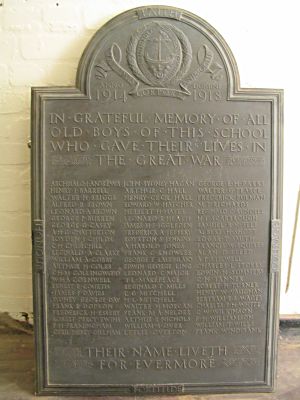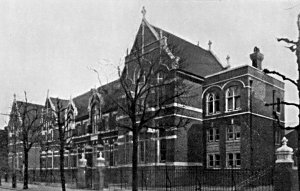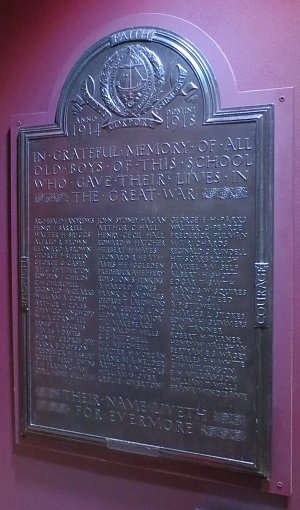
The WW1 Memorial

The WW2 Memorial

The Boys Secondary School in 1911 from Victoria Road North

The WW1 Memorial at the 'Lest We Forget' Exhibition 2014
I first became aware of the existence of the Memorial tablets from a copy of the School History written in 1954 by Mr. A.C. Hitchins. The book contains simplified illustrations of the two plaques showing just the names on the Rolls of Honour. In 2006 we were able to visit the College and obtain photographs of the WW2 tablet which still existed in situ. At that time there was no trace of the WW1 Memorial. Some weeks later however the WW1 Memorial was discovered in the lift motor room. Both memorials are now (2014) in the hands of the City Museum Service for safe keeping.
There is a curious inconsistency between the list of names on the WW2 Memorial as published by Hitchins and the actual plaque. In the former, Hitchins lists 63 names (including one from the Korean War) whilst the actual tablet holds 81 names. The names on the WW1 Memorial in the book corresponded exactly with the names on the plaque, though on the plaque the names are spelt out in full (where known) and in the book just the initials are used for the first names.
The links below lead to the two lists of names, both being transcripts of the plaques but the latter showing by the use of asterisks which names were omitted from the book. In addition there are four names in the book but not on the plaque.
1. Former Pupils Roll of Honour (World War I)
2. Former Pupils Roll of Honour (World War II)
[Thanks to Peter Higgins for correcting some errors in the report above and for pointing out that there is now a website dedicated to the Southern Grammar School]
Tim Backhouse
History
The Southern Grammar School existed in various guises and in several locations from it's foundation in 1888 as a Higher Grade School based initially above the shops of Messrs Pink at the junction of Commercial Road and Sultan Road. Within four years however it had moved to purpose built premises on land between Victoria Road North and Fawcett Road (now occupied by Priory School).
In 1904 the school was designated a Boys Secondary School, but in 1914 the building was taken over for use as a military hospital and the boys were moved to Lyndhurst Road Elementary School. At the end of the Great War it was decided that a fitting memorial should be erected to those former members of the school who had given their lives. The Memorial took the form of a bronze tablet and a book containing photographs and short biographies of the fallen; it was unveiled in the Victoria Road North building by Alderman FG Foster JP on April 15th 1921. Alderman Foster also presented to the school an inkstand made from an oar from HMS Hampshire, on which three of the Old Boys of the school had perished.
At the outbreak of the Second World War the school was evacuated to Brockenhurst in the New Forest and on the night of Friday January 10th The Victoria Road Building was hit by High Explosive bombs. The building was almost completely destroyed but amazingly the bronze WW1 memorial was recovered from the debris, though the memorial book and inkstand were lost. The bronze tablet was restored and re-erected in what was described as "the present school" by AC Hitchins in his history of the school written in 1954.
When the school returned from Brockenhurst, alternative accommodation for it was secured at the Highland Road School where it was known as the Southern Secondary School for Boys. The premises were however too small for the expanding pupil numbers and almost immediately after the war plans were under way to construct a brand new building. At the same time it was proposed to raise money for a Second World War Memorial which was to take the form of a tablet and a new organ for the new school which was taking shape at Baffins. The new school opened in 1956 (the official opening was performed by D.F Foster B.A., T.D., M.P - Parliamentary Secretary, Ministry of Education on Friday, 8th June) with the organ and tablet installed in the main hall.
By this time the school had become Portsmouth Southern Grammar School for Boys, a name that was to last but a couple of decades before the school's role changed again and it became Portsmouth College.
In 2006 it was proposed to substantially alter the character of the main hall and this necessitated the de-commissioning of the organ and the removal of the Memorial tablet. At the time of writing (2007) the WW2 Memorial plaque and the organ console are in store at Portsmouth College.
In 2014 the City Museum hosted an exhibition called 'Lest We Forget' which commemorated the beginning of the Great War. The Grammar School memorial was one of the exhibits.
